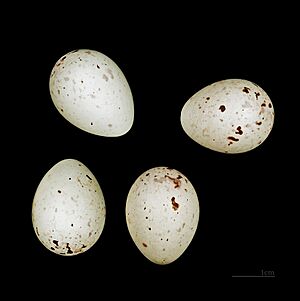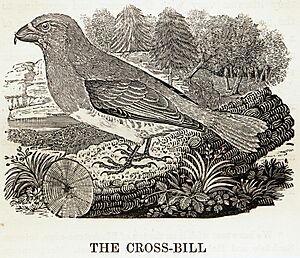Red crossbill facts for kids
Quick facts for kids Red crossbill |
|
|---|---|
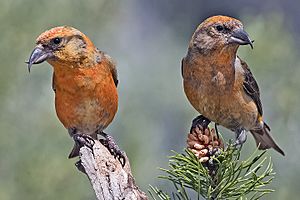 |
|
| Male red crossbill | |
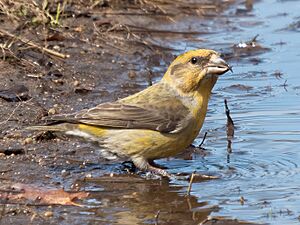 |
|
| Female red crossbill | |
| Conservation status | |
| Scientific classification | |
| Genus: |
Loxia
|
| Species: |
curvirostra
|
 |
|
| Range of L. curvirostra Breeding Resident Non-breeding Vagrant (seasonality uncertain) | |
The red crossbill (also called the common crossbill) is a small bird in the finch family. Its scientific name is Loxia curvirostra. These birds are special because their top and bottom beaks cross over at the tips. This unique beak helps them get seeds out of pine cones and other fruits.
Adult red crossbills are often brightly colored. Males are usually red or orange, while females are green or yellow. There are many different types of red crossbills, which can have slightly different beak sizes and shapes, and even different calls. Because of these differences, some types are considered subspecies, which are like different groups within the same species. In North America, it's known as the "red crossbill," and in Europe, it's called the "common crossbill."
Contents
What They Look Like
Crossbills are easy to spot because of their crossed beaks. This is how they got their name! They use their crossed beaks like a tool to open up the scales of pine cones. This helps them pull out the seeds they love to eat. As mentioned, male crossbills are usually red or orange, and females are green or yellow. But remember, there can be a lot of variety in their colors.
How to Tell Them Apart
Their crossed beaks make them unique, but there's another bird called the two-barred crossbill that also has crossed beaks. You can tell the two-barred crossbill apart because it has two bright white stripes on its wings. The red crossbill's wings are all brownish-black.
The red crossbill is usually the only crossbill with dark wings in most places. However, it can sometimes be found in the same areas as the parrot crossbill, Scottish crossbill, and Cassia crossbill. These birds look very similar to the red crossbill. It's hard to tell them apart just by looking at them. The best way to identify them is by listening to their calls. Even though they look alike, their calls are different!
Measurements:
- Length: About 20 cm (8 inches)
- Weight: 40-53 grams (about 1.4-1.9 ounces)
- Wingspan: 27–29 cm (about 10.5-11.5 inches)
Reproduction and Travel
Red crossbills make their homes in different kinds of pine and fir forests across North America and Eurasia. Their movements depend a lot on where they can find conifer seeds, which are their main food. They usually build nests in late summer (June to September) when most conifer seeds are ready. But if they find a good supply of cones, they can nest at any time of the year!
These birds are known for being "nomadic" and "irruptive." This means they don't stay in one place for long and often travel far. Why? Because the number of conifer seeds can change a lot from year to year. If there aren't enough seeds where they are, they will fly to new places to find food and raise their young. In some areas, you might see them one year and not the next because their visits are "irregular."
Different types of red crossbills prefer different kinds of conifer trees. This can affect when and where they travel. Some groups, like the Newfoundland crossbill, stay in one place and don't move much. When they are not breeding, different types of red crossbills might gather together. They might even join flocks with other kinds of crossbills.
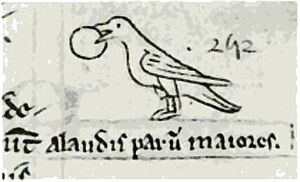
People have noticed red crossbills traveling in large groups, called "irruptions," for a very long time. In the British Isles, these big movements don't happen often. Writers from the 13th century even wrote about them! These travels eventually led to crossbills starting to live and breed permanently in England and Ireland.
The first recorded irruption was in England in 1254. A writer named Matthew Paris described "certain wonderful birds" that had never been seen before. They were "a little bigger than Larks" and ate only the seeds of apples. He noted their crossed beaks, which they used "as with a forceps or knife" to open the apples. The parts of the apples they left behind looked "as if they had been infected with poison." Another big irruption happened in 1593. People were amazed by these "unknown birds" that came to England and ate only the apple seeds. They described how the birds' beaks were "admirably adapted by nature" to divide the apples.
About Their Names and Types
The red crossbill was officially named by a Swedish scientist named Carl Linnaeus in 1758. He gave it the scientific name Loxia curvirostra. The name Loxia comes from an ancient Greek word meaning "crosswise," which refers to its beak. Curvirostra is Latin for "curved bill."
The red crossbill is a great example of how animals can adapt to their environment. There are about 10 types in North America and 18 types in Eurasia! Each type has adapted to eat seeds from a specific kind of conifer tree. Even though they might eat from different trees when they're not breeding, they do best when they raise their young near their favorite tree. This helps keep the different types from mixing too much. Over time, this has caused them to become slightly different from each other, especially in their calls.
Birds of all types look almost the same. But their calls, especially their single "chip" calls, are quite different! Scientists often use computers to tell the call types apart. But experienced bird watchers can learn to recognize the more distinct calls just by listening.
These different groups are called "types" because they are identified by their calls. Not all of them have been proven to be genetically different yet. But some groups that are genetically distinct are called "subspecies." As scientists learn more, they expect that more of these subspecies will eventually be recognized as completely separate species.
For example, three groups that used to be considered types of red crossbills are now recognized as full species:
- Scottish Crossbill (Loxia scotica)
- Parrot Crossbill (Loxia ptyopsittacus)
- Cassia Crossbill (Loxia sinesciuris)
Scientists are still studying some large-billed crossbills in the Mediterranean area. These birds mostly eat seeds from pine trees like the Aleppo pine and European black pine. They might be new species or belong to the parrot crossbill group. These birds can also have slightly different feather colors, but this often depends on the type of cones they eat.

There are many different types of red crossbills, each often linked to a specific type of tree. For example, the Newfoundland crossbill (Type 8) is often found eating seeds from black spruce trees. Other types might prefer western hemlock, Douglas fir, or different kinds of pines. Scientists use their calls to identify these different types, as their appearance can be very similar.



